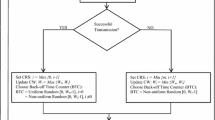Abstract
The main mechanism in IEEE 802.11 to access the medium is distributed coordination function (DCF) as a random access scheme based on carrier sense multiple access with collision avoidance. DCF describes two access techniques for packet transmission, namely basic access mechanism and request to send/clear to send mechanism. A new backoff algorithm has been proposed here for high load traffic in IEEE 802.11. The proposed algorithm is called maximum increment double decrement (MIDD) which gradually reduces the size of windows in a successful transmission and maximizes it in an unsuccessful one. Meanwhile, a mathematical analysis has been developed for MIDD algorithm based on studying Markov chain and performance analysis of the suggested algorithm. Results from this analytical model of MIDD algorithm are compared with those of IEEE 802.11 and double increase, double decrease algorithm, while the results of the throughput analysis have been examined on these three algorithms. The obtained results demonstrate that a great increase of windows size in the unsuccessful transmission as well as a small decrease of windows size in the successful transmission are beneficial for the high traffic conditions. However, a small increase of the windows size in the unsuccessful transmission and a large decrease of it in the successful transmission are ideal for the low traffic case.

Similar content being viewed by others
References
Subathra P., Radha Krishnan P., Sivagurunathan S.: A cluster-based reliable token circulation scheme for group communication in MANET. AJSE. 37, 647–664 (2012). doi:10.1007/s13369-012-0195-4
Naeini V., Movahhedinia N.: Packet scheduling and admission control for QoS provisioning in integrated IEEE 802.11e and IEEE 802.16 Mesh Mode. AJSE. 37, 1595–1611 (2012). doi:10.1007/s13369-012-0262-x
Moses E.: Managing cell congestion in broadband wireless networks: a comprehensive simulation approach. AJSE. 37, 631–645 (2012). doi:10.1007/s13369-012-0198-1
Mathana, J.M.; Rangarajan, P.; Perinbam, J.R.P.: Low complexity reconfigurable turbo decoder for wireless communication systems. AJSE (2013). doi:10.1007/s13369-012-0495-8
Eissa T., Razak S. A., Ngadi M.A.: A novel lightweight authentication scheme for mobile ad hoc networks. AJSE 37, 2179–2192 (2012). doi:10.1007/s13369-012-0318-y
IEEE 802.11g: 54 Mbit/s, 2.4 GHz standard (backwards compatible with b) (2003)
IEEE 802.11b: Enhancements to 802.11 to support 5.5 and 11 Mbit/s (1999)
IEEE 802.11h: Spectrum managed 802.11a (5 GHz) for European compatibility (2004)
Vardakas, J.S.; Papapanagiotou, I.; Logothetis, M.D.; Kotsopoulos, S.A.: On the end-to-end delay analysis of the IEEE 802.11 distributed coordination function. In: Proceedings of the IEEE International Conference on Internet Monitoring and Protection (2007). doi:10.1109/ICIMP.2007.29
Bianchi G.: Performance analysis of the IEEE 802.11 distributed coordination function. IEEE J Sel Area Commun. 18, 535–547 (2000)
Sakakibara, K.; Chikada, S.; Yamakita, J.: Analysis of unsaturation throughput of IEEE 802.11 DCF. In: Proceedings of the International Conference on Personal Wireless Communications (2005). doi:10.1109/ICPWC.2005.1431318
Wang, Y.; Yan, N.; Li, T.: Throughput analysis of IEEE 802.11 in multi-hop ad hoc networks. In: Proceedings of the International Conference on Wireless Communications, Networking and Mobile Computing (2006). doi:10.1109/WiCOM.2006.239
Zhang, H.; Zhao, R.; Gao, Z.: Performance analysis of the 802.11 with a new model in nonsaturated conditions. In: Proceedings of the International Conference on Information Networking and Automation (2010). doi:10.1109/ICINA.2010.5636374
Kadiyala, M.K.; Shikha, D.; Pendse, R.; Jaggi, N.: Semi-Markov process based model for performance analysis of wireless LANs. In: Proceedings of the International Conference on Pervasive Computing and Communications Workshops (2011). doi:10.1109/PERCOMW.2011.5766962
Taher, N.C.; Doudane, Y.G.; Hassan, B.E.: A complete and accurate analytical model for 802.11e EDCA under saturation conditions. In: Proceedings of the International Conference on Computer Systems and Applications (2009). doi:10.1109/AICCSA.2009.5069420
Kumar, P.; Krishnan, A.: Throughput analysis of the IEEE 802.11 distributed coordination function considering capture effects. In: Proceedings of the International Conference on Emerging Trends in Engineering and Technology (2010). doi:10.1109/ICETET.2010.77
Malone D., Duffy K., Leith D.: Modeling the 802.11 distributed coordination function in Nonsaturated Heterogeneous Conditions. IEEEACM Trans. Netw. 15, 159–172 (2007)
Manshaei, M.H.; Cantieni, G.R.; Barakat, C.; Turletti, T.: Performance analysis of the IEEE 802.11 MAC and physical layer protocol. In: Proceedings of the International Symposium on World of Wireless Mobile and Multimedia Networks (2005). doi:10.1109/WOWMOM.2005.76
Sun G., Hu B.: Delay analysis of IEEE 802.11 DCF with back-off suspension. J. Future Gener. Commun. Netw. 1, 148–151 (2007)
Pollin S., Ergen M., Ergen S., Bougard B., Perre L.D., Moerman I., Bahai A., Varaiya P., Catthoor F.: Performance analysis of slotted carrier sense IEEE 802.15.4 medium access layer. IEEE Wirel Commun. 7, 3359–3371 (2008)
Golen, E.F.; Nozaki, Y.; Shenoy, N.: An analytical model for the neighbor turn taking MAC protocol. In: Proceedings of the International Military Communications (2008). doi:10.1109/MILCOM.2008.4753414
Tian, G.; Tian, Y.C.: Modelling and performance evaluation of the IEEE 802.11 DCF for real-time control. Comput Netw. 56, 435–447 (2012). doi:10.1016/j.comnet.2011.10.001
Hung K.L., Bensaou B.: Throughput analysis and bandwidth allocation for IEEE 802.11 WLAN with hidden terminals. J Parallel Distr Comput. 71, 1201–1214 (2011)
Khawam K., Ibrahim M., Abdennebi M., Marinca D.; Tohme, Marinca D.; Tohme: Analytical modeling in 802.11 ad hoc networks. J Comput Commun. 1, 1883–1891 (2011)
Zhalehpour, S.; Shahhoseini, H.S.; Zhalehpour, S.: Performance evaluation of adaptive backoff algorithms in ad hoc networks. In: Proceedings of the International Conference on Computer Technology and Development (2009). doi:10.1109/ICCTD.2009.238
Chatzimisios, P.; Vitsas, V.; Boucouvalas, A.C.; Tsoulfa, M.: Achieving performance enhancement in IEEE 802.11 WLANs by using the DIDD backoff mechanism. Int J Commun Syst. 23–44 (2007)
Author information
Authors and Affiliations
Corresponding author
Rights and permissions
About this article
Cite this article
Shahhoseini, H.S., Afhamisisi, K. & Meamari, E. Increasing Performance in IEEE 802.11 for High Traffic by MIDD Backoff Algorithm. Arab J Sci Eng 39, 4609–4616 (2014). https://doi.org/10.1007/s13369-014-1091-x
Received:
Accepted:
Published:
Issue Date:
DOI: https://doi.org/10.1007/s13369-014-1091-x




